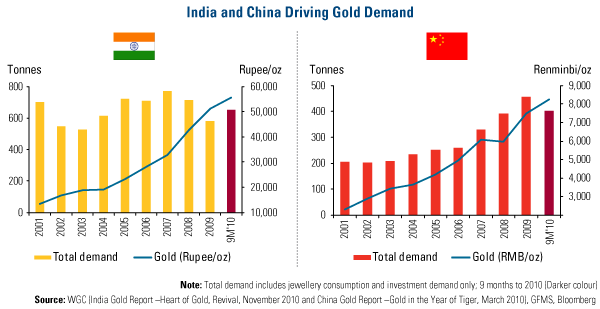India and China Continue to Drive Gold Demand
The World Gold Council’s (WGC) latest quarterly recap shows global gold demand is getting stronger despite rising gold prices. Gold rose 28 percent to record the highest average price for a quarter ever at $1,226.75 an ounce while gold demand jumped 12 percent on a year-over-year basis to 921.8 tons during the quarter.
Jewelry demand, which increased 8 percent on a year-over-year basis, accounted for 57 percent of overall demand, while investment demand rose 19 percent to account for 31 percent of total demand.
It appears consumers and investors, especially in India, China, Russia and Turkey, are growing accustomed to higher gold prices. At the end of the third quarter, gold demand in India had already exceeded that of 2009 and demand levels in China are ahead of last year’s pace.

The WGC says “these results demonstrate that consumers in these countries are becoming accustomed to high price ranges…and consumers are preferring to make gold jewelry purchases at current prices in order to avoid purchasing at higher prices in [the] future.”
Investment demand rose despite a 7 percent decline in investment in ETFs, which has been the biggest driver in investment demand of late.
Chinese investors seeking protection from rising interest rates directed a considerable portion of their savings into gold products, causing demand for gold bars to jump 44 percent. Net retail investment in China reached 45 tons, breaking the previous record of 40 tons set in the first quarter of 2010.
We’ve said this many times, as the economy recovers and per capita incomes in countries such as China and India rise, consumers and investors within those countries will likely see gold as a key investment vehicle because of the cultural connection carried over thousands of years.
Additionally, the official sector—central banks—were net buyers of gold with Russia, Sri Lanka, Thailand and Philippines increasing their holdings. This offset the International Monetary Fund’s continued selling of gold under the current Central Bank Gold Agreement.
More News
{{ commodity.name }}
{{ post.title }}
{{ post.date }}

Comments